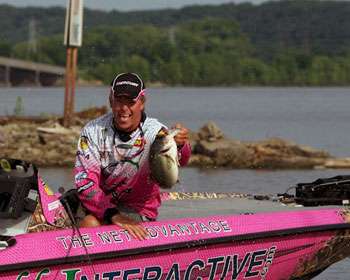
Arkansas pro Kevin Short is a thoughtful practitioner of his craft, a renowned river rat who recently took home $100,000 by winning the Elite Series tournament on the Mississippi River. Put him on a river anywhere in the country and he's going to figure it out in a hurry.
As any river veteran will tell you, current is key when it comes to catching bass on river systems. But as much as current matters, one critical piece of the puzzle is locating areas that block current — places where big bass can lie in wait to ambush an easy meal. While Short may never have seen a particular river before, when he gets there he'll look for certain elements. Among his favorites are wing dams and jetties.
These two man-made fish magnets are obstacles that extend part-way across the river in order to funnel the current to the center of the river, thereby slowing sediment accumulation in the channel and ensuring navigability. They're usually made of rock or wood.
While any of them can hold a fish or two, some are better than others, so when other anglers are also capitalizing on this pattern it's critical to find the best of the bunch.
The first thing Short looks for are wing dams or jetties located near deep water. For example, jetties located on a channel bend are often used by bass as a migration route. Accordingly, those that meet this criteria tend to "hold the highest concentration of fish," according to Short.
The second indicator of a good jetty or wing dam is the presence of bait. "Whether they're up on the rocks feeding on algae, suspended off the ends or behind it, if there are shad around, there ought to be some bass around, too," Short explains.
Even within the structure itself, it pays to focus on particular high-percentage areas. An angler can fish around a lengthy wing dam without a bite but then get to the sweet spot and quickly boat a limit.
"A lot of times there's one big rock or a group of rocks that stick out," Short says. "In many cases, you can't see it until you fish it. But a lot of them will have something different, like a log lodged against it. If you catch a fish off something like that, come back an hour or two later and you'll probably catch another fish because those places 'reload.' "
When approaching one of these mini-dams, Short usually focuses his efforts on the upcurrent side first. You can catch a few fish on the downcurrent side, sometimes even more than upcurrent but the best bass are usually first in line for the buffet coming down the river.
"Particularly if there are some big rocks that the fish can get into, that's where they'll be," he said. "They know they need to get to the food first."
Short's No. 1 search tool in these instances is a crankbait, like a Strike King Series 3 or 4S. "I'll go to a (deeper diving) Series 5 in the summer when the current slows down and the water is clear, particularly on the Arkansas River. But if it's dirtier, the fish will be up shallow."
If the water's clear, and they don't want the lipped crankbait, his next choice is a small spinnerbait, like a Strike King Burner, which he can move fast without breaking the surface but still has a small profile. "You can just bump it along the rocks if you see shad," he said.
Sometimes, Short will pick off the aggressive fish with the moving baits but if he's convinced that a "little stick out" just has to hold another bass, he'll slow down and probe the cover with a 1/2- or 5/8-ounce Jewel J Lock Flip'n Jig.
Once he's established the best wing dam or jetty, or the best series of them, he's still not likely to camp on just one during a tournament. "You've got to keep moving," he advised. "Don't worry if someone is in front of you or behind you. They might be throwing the wrong bait, or they might be fishing the wrong depth."





